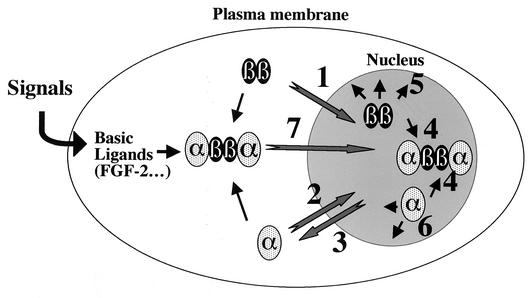FIG. 7.
Model for intracellular dynamics of CK2 subunits. As previously suggested (12) and suggested in this study, each neo-synthesized CK2 subunit is separately imported into the nucleus through specific mechanisms (1 and 2). Unlike CK2β, nuclear CK2α can be exported back through an exportin 1/Crm1-dependent pathway (3). Once in the nucleus, CK2 subunits are freely mobile and may roam by diffusion through the nucleoplasm at a high rate, where they can either associate in a stochastic manner to generate the holoenzyme (4) or interact with appropriate binding partners or nuclear structures, leading to a subpopulation of slow-moving CK2 subunits highly restricted in their mobility (5 and 6). Likewise, cytoplasmic CK2 subunits may also bind to each other generating, the holoenzyme which would remain in the cytoplasm to phosphorylate specific protein substrates in this compartment. Cell signaling pathways may also generate allosteric binding ligands (such as FGF-2) that would target the nuclear translocation of the holoenzyme (7).

